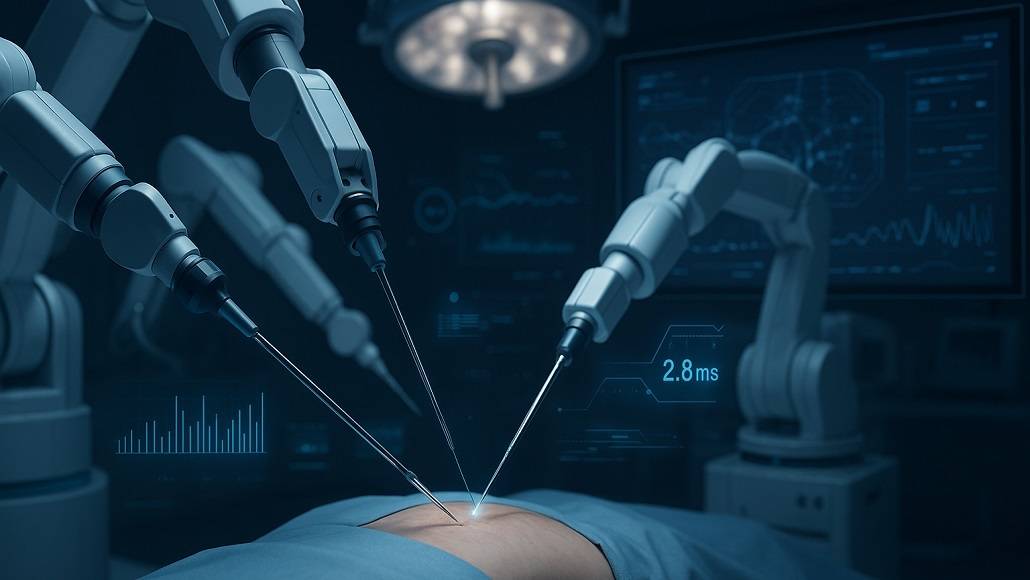In the high-stakes world of surgical robotics, every millisecond counts. As robotic systems become more important in operating rooms, it is more important than ever to have advanced software that makes sure surgeons can control the robots precisely and communicate with them easily. This is important for reducing trauma and speeding up patient recovery.
A QNX study backs up this change by showing that 77% of technology leaders now trust robots to “perform essential workplace functions.” The two biggest reasons for this trust are improvements in safety and risk reduction (42%) and proven reliability and performance (40%). These aren’t just numbers; they’re the keys to a successful surgery.
Milliseconds are important
Imagine a robot end-effector moving around a group of important nerves. A delay of 100 milliseconds, which is less than the time it takes to blink, can cause damage that can’t be fixed. The millisecond challenge is to build systems that can respond in real time with perfect accuracy, even when things are at their most difficult.
To meet this challenge, surgical robots need to be tested in real-world situations that are always changing, like when a patient moves or a tool is moved, to make sure the system can adapt and respond quickly. In robotic surgery, every part of the system, from camera feeds to haptic responses, needs to be set up so that it works almost instantly. This lets surgeons work with confidence and accuracy.
Seamless hardware-software synchronization
Speed isn’t the only thing that matters in robotic surgery. It’s all about timing. For results to be reliable and consistent, hardware and software must work together perfectly. Integrated GPUs are very important because they allow for real-time processing of ultra-high-definition 3D visuals, which is necessary for surgeons to see clearly when doing complicated procedures.
It is also important for data to flow smoothly between subsystems. When haptic and visual systems are set up for high throughput, they give instant feedback. This smooth integration is what turns robotic systems from tools into trusted partners in surgery.
Why low latency and jitter are important
Latency (the time it takes for an input to be processed) and jitter (the difference in that time) are very important for surgical robots. A system that responds quickly but not always can be just as dangerous as one that is slow.
Systems need to keep their latency and jitter very low to make sure they are accurate and responsive. To reduce timing-related risks and make sure real-time performance, this needs very effective ways to handle interrupts. The most important thing to do with signals like changes in tool position or sensor alerts is to act on them right away. Setting up time-triggered task scheduling cuts down on jitter even more, making sure that all feedback loops work with consistent and predictable timing.
To build trust with patients, these technical improvements are needed. The QNX study shows that 70% of tech executives are fine with working with robots, but only 51% trust them to do medical procedures. To close this gap, we will need not only new technologies but also proof that they work consistently in the real world.
RTOS: The heart of surgical robots
The real-time operating system (RTOS) is like the conductor of this orchestra, making sure that sensors, actuators, and surgical interfaces all work together perfectly and that every part works with microsecond-level accuracy.
An RTOS like QNX OS 8.0 isn’t just about running multiple tasks at the same time; it’s also about making sure that each task is done with the highest level of precision, accuracy, and speed. The RTOS needs to be carefully set up so that it works well with the hardware and end-user applications, handling many high-priority tasks at the same time with as little latency and jitter as possible.
Reliability and scalability
As surgical robotics gets better, systems need to be made to handle not only the problems of today but also the new ideas of tomorrow. It’s important that things can grow and are reliable. Modular system design makes it easy to add new technologies like AI and machine learning to surgical applications as they become available.


















